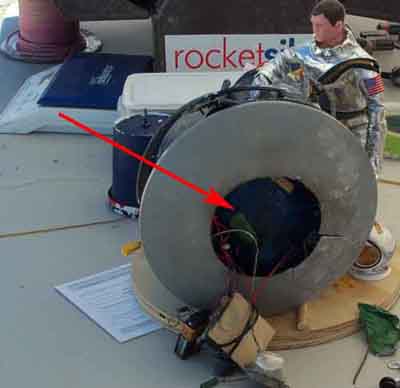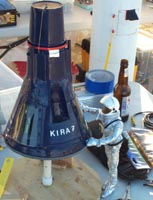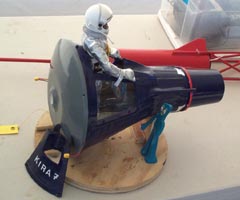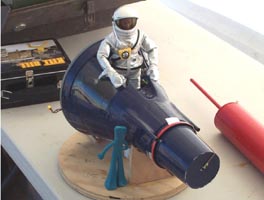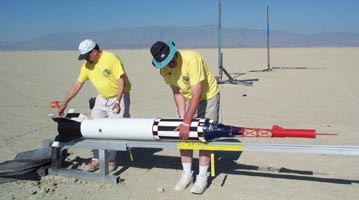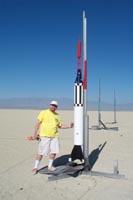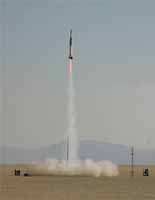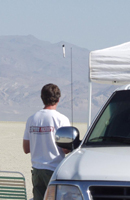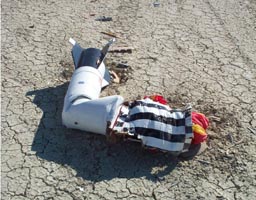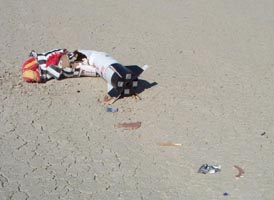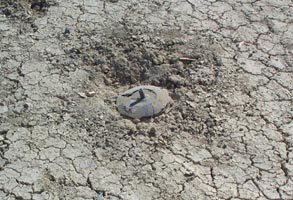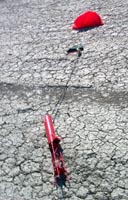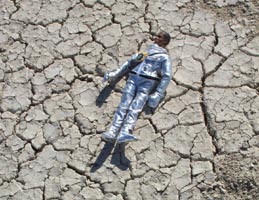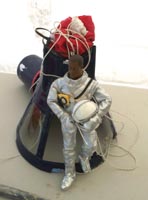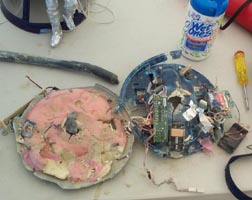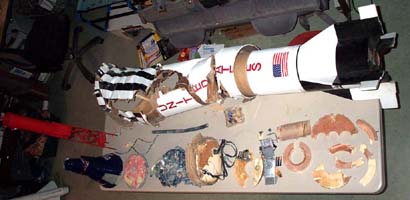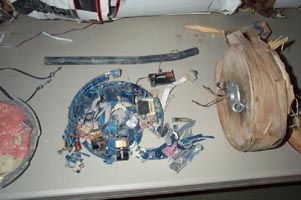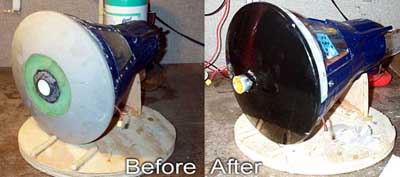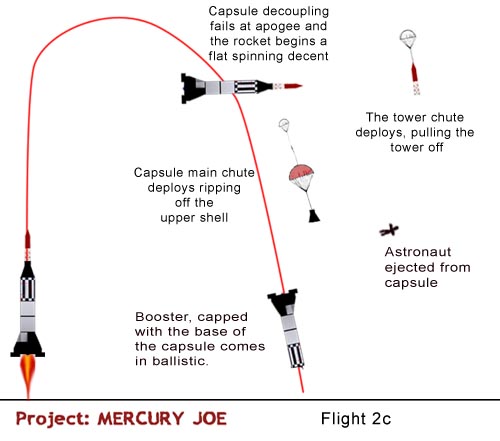
Video of break-up with ground tracking in WMV format
Slow motion tower video of launch to break-up in MOV format
Half speed tower video of break-up only in MOV format
Astronaut John Shaft
FLIGHT 2C - AMW L1100 RR
Goals
-
Test System under L Power
-
Test the free fall capsule recovery system
-
Test new camera mount for the booster camera
Technical details
-
The Tower will release the capsule, allowing it to proceed with the free fall.
-
G-Wiz avionics for deploying the recovery system after the free fall.
-
Repaired capsule, Kira 7 goes for its second flight
-
Improved DVII video/audio capture cockpit camera
Results
-
Beautiful and stable launch
-
Capsule decoupling failed
-
Booster free fell and spun so hard it caused the tower to deploy its chute.
-
Capsule chute deployed and pulled the shell of the capsule off
-
The booster with the parachute trapped inside came in ballistic
-
Capsule avionics and camera system on the leading end of the booster are destroyed on impact
-
Booster camera destroyed on impact
-
Tower was slightly zippered and a couple of struts broke
-
Tower video reception sucked, need to look at what may be wrong
-
Astronaut was ejected and free fell to the playa "safely"
-
Booster Gwiz LC undamaged
-
All parachutes were undamaged
-
The upper capsule shell was still in good shape (considering)
-
Tower Avionics, Camera and transmitter undamaged
-
Motor undamaged
Aeronaut, July 31st 2004, the third flight of Season 2 took flight and ended with 70 percent of the rocket damaged beyond repair.
The launch on an AMW L-1100 was picture perfect but just after apogee the entire rocket began a back slide. This wasn’t the first time we had seen that behavior, flights 2a and 2b this season did a similar back slide for a second or two but the capsule decoupling occurred. Concern didn’t really set in until flight 2c had fallen way past apogee and began a vigorous axial spin.
The spin increased to the point that the video tower’s nose cap came free, exposing its parachute. Once fully inflated, the tower parachute (way too small for the 30lb mass of the rocket) pulled the tower off the capsule and along with it the capsule’s nose cap. This exposed the capsule's drogue chute that subsequently extracted the main chute.
When the capsule’s main chute inflated, the stress was too great for the attachment points that held it onto the heat shield (still shear-pinned to the booster) and the upper shell broke free. While the tower and upper capsule shell safely recovered under chute, the Redstone booster became ballistic and drove itself head first into the playa.
Reconstructing exactly what caused the failure is difficult, but one thing is for certain; the ejection charge for decoupling had gone off. This fact allows for 3 basic theories:
-
The PVC chamber that housed the charge failed and absorbed the decoupling charge
-
There was insufficient charge to decouple the capsule from the booster
-
The floor of the capsule failed and absorbed the decoupling charge
Though severely damaged the PVC chamber looked to be intact with no evidence of stress from within. After rebuilding the heat shield / coupler system, I conducted tests of flight 2c’s configuration and in each test the results were a successful separation. This pretty much eliminated theories 1 and 2, leaving theory 3 as the only (offered) likely cause; that the floor of the capsule collapsed when the ejection charges blew, absorbing the pressure that would have otherwise separated the capsule from the booster.
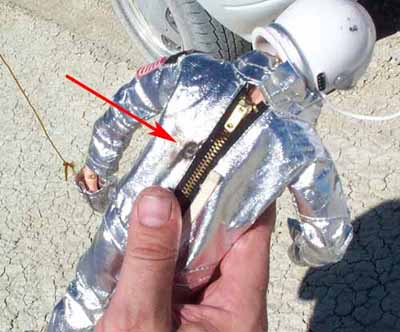
|
Further support for the floor failure was perhaps forewarned in Mercury Joe's maiden voyage at XPRS in 2003. In that flight the tower broke free and damaged the recovery system for the capsule, but the decoupling occurred, saving the booster. The capsule free fell about 1000 feet and sustained significant damage but was well within reason for repair. A harbinger of flight 2c's failure might have been the burn marks on the back of the GI Joe's flight suit and the lack of debris found from the central coupling mount. At the time, the damage to the heat shield was attributed to the capsule's hard landing on the playa and the burn marks on the flight suit simply an interesting anomaly.
|
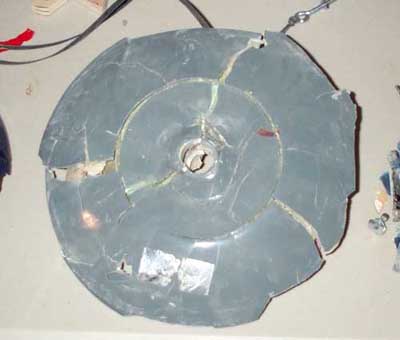 |
Looking at the shattered heat
shield from flight 2c, it's easy to imagine the center section
collapsing, though this section of the rocket was flattened into the
playa.
Unfortunately, the on-board video capture from the booster and capsule were lost in the crash. This might have shed more light on what caused the failure, especially the cockpit camera that was without a doubt functional and recording all the way up to impact. |
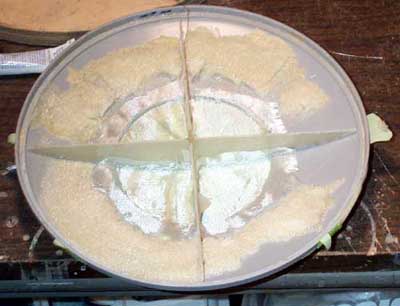
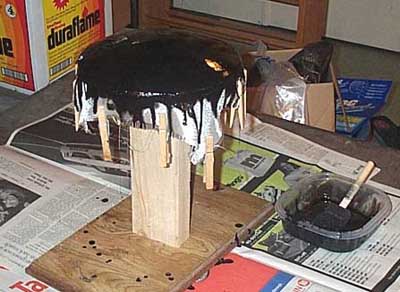
Epilog
Decoupling is essential for a successful flight, so naturally this area needs significant structural enhancement.
To achieve this, the heat shield section of the capsule has been totally rebuilt (with parts from 2a's capsule) to have a G10 fiberglass cross frame and 5 ounce fiberglass covering the entire base.
Moving the coupling joint outside the curve of the heat shield allows the internal structure to be stronger, continuous and less susceptible to failure.
This new improved heat shield reduces (if not eliminates) the possibility that this failure will reoccur and a shake down flight will be conducted before proceeding to fly this under M power.
